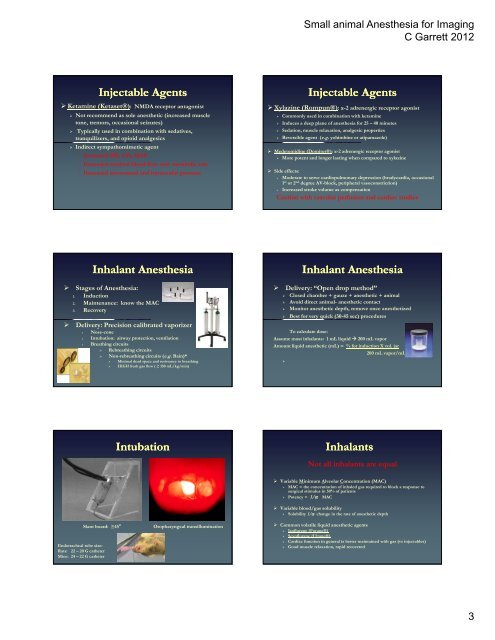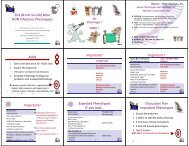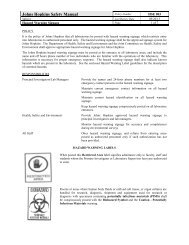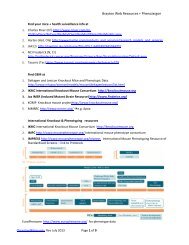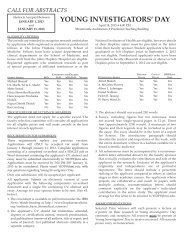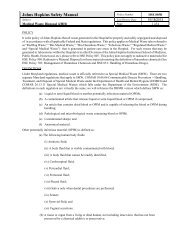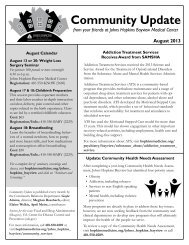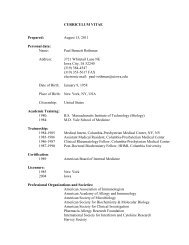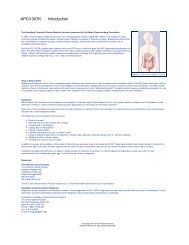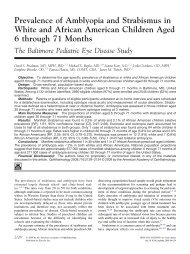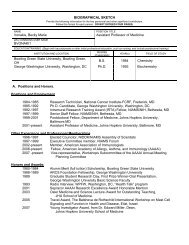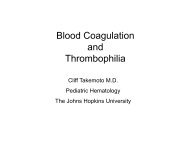Overview Key Concepts Anesthetic Management Anesthestic ...
Overview Key Concepts Anesthetic Management Anesthestic ...
Overview Key Concepts Anesthetic Management Anesthestic ...
Create successful ePaper yourself
Turn your PDF publications into a flip-book with our unique Google optimized e-Paper software.
Small animal Anesthesia for Imaging<br />
C Garrett 2012<br />
Injectable Agents<br />
‣ Ketamine (Ketaset®): NMDA receptor antagonist<br />
‣ Not recommend as sole anesthetic (increased muscle<br />
tone, tremors, occasional seizures)<br />
‣ Typically used in combination with sedatives,<br />
tranquilizers, and opioid analgesics<br />
‣ Indirect sympathomimetic agent<br />
‣ Increased HR, CO, MAP<br />
‣ Increased cerebral blood flow and metabolic rate<br />
‣ Increased intracranial and intraocular pressure<br />
Injectable Agents<br />
‣ Xylazine (Rompun®): α-2 adrenergic receptor agonist<br />
‣ Commonly used in combination with ketamine<br />
‣ Induces a deep plane of anesthesia for 25 – 40 minutes<br />
‣ Sedation, muscle relaxation, analgesic properties<br />
‣ Reversible agent (e.g. yohimbine or atipamazole)<br />
‣ Medetomidine (Domitor®): α-2 adrenergic receptor agonist<br />
‣ More potent and longer lasting when compared to xylazine<br />
‣ Side effects:<br />
‣ Moderate to serve cardiopulmonary depression (bradycardia, occasional<br />
1 st or 2 nd degree AV-block, peripheral vasoconstriction)<br />
‣ Increased stroke volume as compensation<br />
Caution with vascular perfusion and cardiac studies<br />
Inhalant Anesthesia<br />
‣ Stages of Anesthesia:<br />
1. Induction<br />
2. Maintenance: know the MAC<br />
3. Recovery<br />
‣ Delivery: Precision calibrated vaporizer<br />
‣ Nose-cone<br />
‣ Intubation: airway protection, ventilation<br />
‣ Breathing circuits<br />
» Rebreathing circuits<br />
» Non-rebreathing circuits (e.g. Bain)*<br />
» Minimal dead space and resistance to breathing<br />
» HIGH fresh gas flow ( ≥ 150 mL/kg/min)<br />
Inhalant Anesthesia<br />
‣ Delivery: “Open drop method”<br />
‣ Closed chamber + gauze + anesthetic + animal<br />
‣ Avoid direct animal- anesthetic contact<br />
‣ Monitor anesthetic depth, remove once anesthetized<br />
‣ Best for very quick (30-45 sec) procedures<br />
To calculate dose:<br />
Assume most inhalants: 1 mL liquid 200 mL vapor<br />
Amount liquid anesthetic (mL) = % for induction X vol. jar<br />
200 mL vapor/mL liq<br />
‣<br />
Intubation<br />
Inhalants<br />
Not all inhalants are equal<br />
Slant board: ≥45°<br />
Endotracheal tube size:<br />
Rats: 22 – 20 G catheter<br />
Mice: 24 – 22 G catheter<br />
Oropharyngeal transillumination<br />
‣ Variable Minimum Alveolar Concentration (MAC)<br />
‣ MAC = the concentration of inhaled gas required to block a response to<br />
surgical stimulus in 50% of patients<br />
‣ Potency = 1/ MAC<br />
‣ Variable blood/gas solubility<br />
‣ Solubility 1/ change in the rate of anesthetic depth<br />
‣ Common volatile liquid anesthetic agents<br />
‣ Isoflurane (Forane®)<br />
‣ Sevoflurane (Ultane®)<br />
‣ Cardiac function in general is better maintained with gas (vs injectables)<br />
‣ Good muscle relaxation, rapid recovered<br />
3


